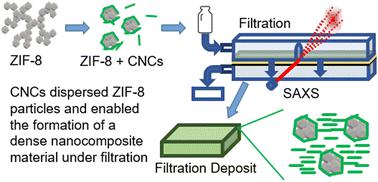当前位置:
X-MOL 学术
›
Soft Matter
›
论文详情
Our official English website, www.x-mol.net, welcomes your
feedback! (Note: you will need to create a separate account there.)
Self-supported MOF/cellulose-nanocrystals materials designed from ultrafiltration
Soft Matter ( IF 2.9 ) Pub Date : 2023-10-16 , DOI: 10.1039/d3sm00798g Lorenzo Metilli 1 , Héloïse Ugo 2 , William Chèvremont 3 , Cyril Picard 2 , Frédéric Pignon 1
Soft Matter ( IF 2.9 ) Pub Date : 2023-10-16 , DOI: 10.1039/d3sm00798g Lorenzo Metilli 1 , Héloïse Ugo 2 , William Chèvremont 3 , Cyril Picard 2 , Frédéric Pignon 1
Affiliation

|
Metal–organic-frameworks (MOFs) are promising materials for addressing critical issues such as petrochemical separation, water purification, energy storage and drug delivery. Their large-scale deployment, however, is hampered by a limited processability due to their powdery nature. Recently, the hybridization of MOFs with biopolymers has emerged as a greener, biocompatible strategy to shape MOFs composites into more processable membranes, films, and porous materials. In this work, cellulose nanocrystals (CNCs) were used in combination with ZIF-8 (a widely used synthetic zeolite) to produce hybrid composites through ultrafiltration. Results showed that small quantities of CNCs (1 to 20 CNC:ZIF-8 volume ratio) were sufficient to form a self-supported, dense deposit with high ZIF-8 loadings. Compared to classical MOF in situ growth strategies, this approach allowed the tuning of the composition of the final nanocomposite by controlling the nature and quantities of particles in the suspension. The fabrication of the deposit was strongly dependent on the physiochemical properties of the suspension, which were fully characterized with a set of complementary techniques, including in situ SAXS. This technique was employed to investigate the filtration process, which exhibited a homogeneous deposition of ZIF-8 particles mediated by CNC self-assembly. Finally, the available pore volume and integrity of the internal porosity of ZIF-8 were characterized by water porosimetry, demonstrating that the presence of CNCs did not alter the properties of the supported ZIF-8.
中文翻译:

采用超滤设计的自支撑 MOF/纤维素纳米晶体材料
金属有机骨架(MOF)是解决石化分离、水净化、能量存储和药物输送等关键问题的有前途的材料。然而,由于其粉末性质,其加工性能有限,阻碍了它们的大规模部署。最近,MOF 与生物聚合物的杂化已成为一种更环保、生物相容的策略,可将 MOF 复合材料塑造成更易于加工的膜、薄膜和多孔材料。在这项工作中,纤维素纳米晶体 (CNC) 与 ZIF-8(一种广泛使用的合成沸石)结合使用,通过超滤生产杂化复合材料。结果表明,少量的 CNC(1 至 20 CNC:ZIF-8 体积比)足以形成具有高 ZIF-8 负载量的自支撑致密沉积物。与经典的 MOF原位生长策略相比,这种方法可以通过控制悬浮液中颗粒的性质和数量来调整最终纳米复合材料的组成。沉积物的制造在很大程度上取决于悬浮液的物理化学性质,这些性质通过一系列补充技术(包括原位SAXS)进行了充分表征。该技术用于研究过滤过程,该过程表现出由 CNC 自组装介导的 ZIF-8 颗粒的均匀沉积。最后,通过水孔隙率测定法对 ZIF-8 的可用孔体积和内部孔隙的完整性进行了表征,证明 CNC 的存在不会改变支撑的 ZIF-8 的性能。
更新日期:2023-10-20
中文翻译:

采用超滤设计的自支撑 MOF/纤维素纳米晶体材料
金属有机骨架(MOF)是解决石化分离、水净化、能量存储和药物输送等关键问题的有前途的材料。然而,由于其粉末性质,其加工性能有限,阻碍了它们的大规模部署。最近,MOF 与生物聚合物的杂化已成为一种更环保、生物相容的策略,可将 MOF 复合材料塑造成更易于加工的膜、薄膜和多孔材料。在这项工作中,纤维素纳米晶体 (CNC) 与 ZIF-8(一种广泛使用的合成沸石)结合使用,通过超滤生产杂化复合材料。结果表明,少量的 CNC(1 至 20 CNC:ZIF-8 体积比)足以形成具有高 ZIF-8 负载量的自支撑致密沉积物。与经典的 MOF原位生长策略相比,这种方法可以通过控制悬浮液中颗粒的性质和数量来调整最终纳米复合材料的组成。沉积物的制造在很大程度上取决于悬浮液的物理化学性质,这些性质通过一系列补充技术(包括原位SAXS)进行了充分表征。该技术用于研究过滤过程,该过程表现出由 CNC 自组装介导的 ZIF-8 颗粒的均匀沉积。最后,通过水孔隙率测定法对 ZIF-8 的可用孔体积和内部孔隙的完整性进行了表征,证明 CNC 的存在不会改变支撑的 ZIF-8 的性能。


















































 京公网安备 11010802027423号
京公网安备 11010802027423号